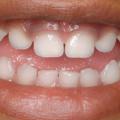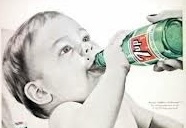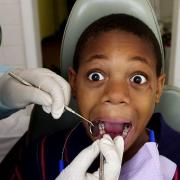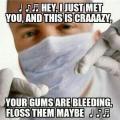Happy 50th DCES!
Happy 50th Annviersary Desert Cove Elementary School! Glad we could be part of the celebration! Good times!
Happy 50th Annviersary Desert Cove Elementary School! Glad we could be part of the celebration! Good times!
Tired of all the sex/nudity, profanity, and violence in PG movies, not to mention PG-13 and R? Check out the ClearPlay BluRay player (plays DVD's as well). Thousands of titles, including all of the latest releases, and YOU control what your kids see. You set the paramaters for 12 different content categories. Take control back from Hollywood!

Read more about Wish all movies were rated G? Here's how they can be.

Why We Love Pediatric Dentistry (And You Should, Too!)
We established Tatum Pediatric Dentistry because it combines two of the things we love the most: dentistry and children. There's a lot to love about pediatric dentistry, and we are excited to come to work every day and help make going to the dentist a positive experience for both children and parents. It would be impossible to list everything that we love about what we do each day, but let's talk about just a few of the reasons why pediatric dentistry is the bomb.com.
First, we get to care for some of the coolest kids in the entire world. It's so rewarding to start caring for our patients as toddlers and watch them grow up a little more with each appointment. When we can teach kids to take great care of their teeth when they are young, they can experience a lifetime of good dental health.
When you work with kids, there is never a dull moment. No two patients are exactly the same, so we're glad we can provide an individualized approach to care. We love getting to know our patients, hearing their funny stories and seeing them leave our office with big smiles on their faces.
Our little patients are also accompanied by their wonderful parents, and we get to know them, too. Our parents truly care about their children's oral health, so we can work together as a team to help them have the best experience possible.
If you've never visited our office, you might not know that we also love to have fun at Tatum Pediatric Dentistry! Our office was designed with children (AND their parents) in mind, so we have everything from toys to video games available to keep everyone happy and entertained.
This is another reason why pediatric dentistry is so great. We get to go to work in a fun, colorful space filled with enjoyable distractions for our valued patients. How many other people can say they have a tree house in their office?
We strive to make our practice a positive place where children of all ages are comfortable, and we love offering incentives and prizes to reward your child's hard work. Kids get to stop by the prize machine after each visit, and we have a special reward for kids who get their teeth fixed and become cavity free.
One of the best things about Tatum Pediatric Dentistry is the fact that we have a wide variety of options and services available. We believe that special needs children deserve comfortable, thorough dental care, too, so we're happy to accommodate your child's unique needs as much as possible. We also offer safe and effective sedation and anesthesia options for patients who need these services.
Some parents have bad memories of visiting the dentist as a child, and we don't want your child to have any negative experiences at Tatum Pediatric Dentistry! From the moment you walk in the door, you'll notice that our office has been carefully designed especially for children AND their parents.
Younger kids love the toys and colorful decorations, while our older patients can pass the time by checking out our iPads or watching a movie on one of our many flat screen TVs. If you prefer to use your own devices, it will only take a second to connect to our free WiFi.
If you haven't experienced the fun and uniqueness of pediatric dentistry, give our office a call today. Our friendly staff members are ready to answer all of your questions and book your first appointment. We accept most dental insurance plans, and other financing options are also available.
We would love to add you to the Tatum Pediatric Dentistry Family! Read more about Why We Love Pediatric Dentistry (And You Should, Too!)

10 Things Cavemen Could Have Taught Your Children About Your Teeth
Though cavemen had dental problems, these were more often due to wear and tear than the cavities we see now, even in children. It seems those cavemen have a thing or two to teach us modern humans! Here’s what they would tell your child to do when it comes to caring for those teeth.
1. Eat like a caveman
Unlike us, cavemen didn’t have processed food to eat, which meant they ate better. So eat more like a caveman by choosing real foods like fruits, vegetables, and healthy proteins, instead of the stuff that comes in packaging. Our over-refined food is too sugary and promotes bacteria that cause plaque, which leads to cavities.
2. Chew like a caveman
Chewing food actually helps clean your teeth and gums. One reason we have problems is that our teeth were not designed for our mushy diets, as every caveman knows. So dig into some whole grains and stringy vegetables, and chew, chew, chew.
3. Avoid fizzy drinks
Did you hear the one about the caveman who spilled his soda drink all over himself? Of course you didn’t, because cavemen didn’t have fizzy drinks. The problem with fizzy drinks is that they’re too sugary, which encourages bad bacteria, and they’re acidic, which weakens the protective hard enamel on your teeth. Once that enamel is gone it never comes back. So how about switching to one of the caveman’s favorite liquid refreshments – water! Your teeth will thank you.
4. Use a straw
If you must drink fizzy drinks, using a straw is better as it helps ensure they do not have as much contact with your teeth. Okay, we didn’t learn about this from cavemen because they didn’t have straws. But you can be sure if cavemen had straws, they’d be using them. The type they’d probably want is a bendy straw, or, if you want to sound super clever, an “articulated straw”.
5. Floss like a caveman?
Maybe cavemen didn’t floss, but some ancient people flossed using long grass blades to clean between their teeth, followed by rinsing with water. Cavemen didn’t have to worry so much about this as there was more space around each tooth, so food didn’t get stuck as easily. We’re not so fortunate, so it’s important to floss. Did you know even monkeys can floss? It’s on Youtube so it must be true!
6. Wear those braces
Any caveman can tell you why you need braces – it’s because your mouth is too small for all your teeth. That’s why you need braces to make them fit in perfectly. It’s also why wisdom teeth often need to come out. We don’t need them anymore, and there just isn’t room.
7. Cleaning modern teeth is harder
Crowded teeth are harder to clean – that’s why we have to try harder than the cavemen did. They didn’t have snag teeth to worry about. If you tell someone they have caveman teeth, you’re giving them a compliment.
8. Fix that overbite
Another modern problem that would be unfamiliar to a caveman is overbite, which needs to be corrected. Their bite was naturally corrected by the rough foods they ate, which wore the teeth down to a perfect fit.
9. Eat some fiber
Eating fiber is not just good for your digestion. It’s also good for your teeth and gums as it naturally helps keep them clean. Want to confuse a caveman? Ask him what gum disease is.
10. Brush every single day
Guess what cavemen didn’t have? Weekends! They didn’t get days off from anything. We’re luckier, but that doesn’t mean you get a day off from cleaning your teeth, ever. So make it a daily ritual. Keep it up and you’ll have a great set of choppers that will last you for a very long time.
Read more about 10 Things Cavemen Could Have Taught Your Children About Your Teeth
 13 Things About Your Child's Teeth You May Not Have Known
13 Things About Your Child's Teeth You May Not Have Known
As your child's teeth come in, there are a few things that you should know to help keep teeth healthy.
1. Baby Teeth are Spaced Apart
As baby teeth come in, they usually have spaces between them. This is to make sure there is room for permanent teeth. The spaces are placeholders for the bigger teeth to take over in the future. When baby teeth are too close together, or no space exists, start saving up for braces :-).
2. Baby Teeth Help Children Learn to Chew and Talk
Baby teeth are not just the first set of teeth a human has, but a set of learning tools. Baby teeth help your children learn how to use their tongues and mouths for chewing and speaking. Without baby teeth, learning how to form certain sounds is almost impossible, making speech difficult.
3. Saliva Cleans Teeth
Saliva washes away bacteria and sugar from your teeth. That doesn't mean you shouldn't brush your teeth! Your saliva is just the first defense against cavities, but not the best one.
4. A Baby's Gums Should Be Brushed Like Teeth
A baby's gums should be cleaned as often as you would brush your teeth. Keeping gums clean and healthy will keep new teeth healthy as well. Use a soft cloth with water or a tiny amount of gum cleanser. Wipe down the gums after feedings and before bed times and naps.
5. Brush Your Child's Teeth Until They Are 8
Parents should help their kids brush their teeth until the age of 8. This is because children do not usually brush teeth well enough for long enough to prevent cavities. Kids should still get the chance to brush their own teeth though. Just have a parent brush them again afterward.
6. Grown Up and Still Cutting Teeth
The final permanent teeth or “wisdom teeth” emerge between 17-21 years of age. Wisdom teeth are frequently removed because they take up too much space in the mouth, or there is no room for them to come in.
7. Snacking Can Rot Teeth
Frequent snacks can lead to tooth decay. Snacking a lot, especially sugary foods, wears on the teeth. Also, the constant eating does not give saliva enough time to clean sugars and bacteria from the teeth between meals. This can give you a cavity!
8. Sticky Foods Lead to Cavities
Sticky and gummy foods are a problem because they are...sticky and gummy. Gooey foods and snacks stick to the teeth. This makes it harder to remove and more likely to get food wedged between the teeth. The longer sugars sit on the teeth, the faster bacteria can form. Bacteria will attack the tooth and cause a cavity.
9. You Will Have Many More Teeth as an Adult Than as a Child
Children will only get 20 baby teeth before they start to fall out to make room for permanent teeth. As an adult, you will have up to 32 teeth altogether. This is including the wisdom teeth. If you have all 4 wisdom teeth removed, you will have 28 permanent teeth as an adult.
10. Milk Can Save a Tooth
No one likes to think about something happening to their teeth, but accidents do happen. If you or your child gets a tooth knocked out, place it in a container of milk. Take the tooth with you to an emergency dentist as soon as possible. The calcium in the milk can save your tooth!
11. Pacifiers and Sucking Thumbs is Okay Until...
Pacifiers and thumb sucking are common for small children. It should not be a concern until about age 3, or if the child does it constantly. Using a pacifier or sucking the fingers can have the same problems as a bottle. Teeth can rot from the bacteria trapped on a pacifier or on the fingers, and more commonly, it can cause an overbite.
12. Baby's First Tooth Should Lead to Baby's First Dentist Appointment
Your child should visit a dentist by their first birthday. This will give the dentist a chance to check on your child's teeth and brushing routines. This is also a good time for your child to get used to the dentist, so he or she does not fear going.
13. If the Teeth Touch, Floss Them
As soon as two teeth touch on the sides, they should be flossed. If teeth are touching, foods can be stuck between them, bacteria can feast, and the toothbrush can't get in there. Flossing is the best way to clean between teeth. Read more about 13 Things About Your Child's Teeth You May Not Have Known

Watch Out: How Candy & Soda Is Taking Over and What to Do About It
The change should certainly start in the home. It is important to train your child's palette in regard to natural foods. Steer kids away from overly processed foods with added sugar. This rule applies to almost all snacks and other kinds of treats that you deem appropriate. For instance, refrain from giving kids artificially sweetened yogurt despite the fact that yogurt seems to be a healthy snack or dessert. The added sugar will make them resistant to natural yogurt in the future and add fuel to the sugar-fuelled fire.
When it comes to desserts, a little extra consideration can go a long way when it comes to shaping the dietary habits of your children. Stick to homemade desserts and non-processed foods as much as possible. You can still satisfy a child's sweet tooth without causing them to develop extremely unhealthy habits. Offer children desserts that are wholesome and naturally sweet such as dark chocolate and fruits. Allowing children to adapt to mildly sweet products can make them predisposed to healthier desserts. If they are rarely exposed to sweetened products that are processed and unhealthy, then the taste of such products can be potentially overwhelming and distasteful for them in the future.
Kids should not be given the impression that sweets are different from any other foods or off limits in general. Develop a healthy attitude towards consuming foods including sugar. Set examples for kids that allow them to understand when it is appropriate to eat sweets and in what kinds of portions as well. Controlling the desire for sweets comes through training that addresses complete eating habits in addition to the types of sugars consumed. Foods should not be labeled as good and bad either. Instead, kids should be educated in the types of food that are vital for health and nutrition versus those types of foods that are simply fun and geared towards satisfying only their taste buds. Help children to understand the proper portions for these foods as well. A good rule of thumb for most parents is the 90 and 10 rule. At least 90 percent of the foods you consume each day should be healthy foods while 10 percent can be snack and fun foods that are naturally sweet.
Communication is also important for children when it comes to sweets. Allowing them to know exactly when they can have sweets lets them look forward to the next time that they enjoy the given treat. If children believe that they will not be given sweets in the future or are subject to harsh guidelines with these substances, then they are much more likely to overindulge when given the chance. After children have been given the proper guidance and allowed time to understand what a healthy approach to sugar is for them, then allow them to take the lead when it comes to desserts. Giving them power to make the right choices themselves will increase their confidence and resolve with their diet. This confidence increases the likelihood that they will make wise choices outside of the home and when faced with peer pressure.
Many parents also fail to educate their children concerning the connection between hunger and food. Children must be trained to recognize their hunger while only consuming foods in order to satisfy that hunger. Many kids will eat simply because food is in front of them. This skill is extremely valuable in the real world. In the home, sweets, soda, and other foods are typically only available at certain intervals or on a meal schedule. Outside of the home, sweets and soda can be available every minute of the day. Understanding that food and sweets are meant to be part of a larger, nutritional plan that is centered on hunger and health is one of the most valuable lessons that children can learn from an early age.

This myth causes lots of long-term problems. The sooner you take care of a problem, such as a cavity or misaligned teeth, the better. That’s why kids should get regular check-ups, even when they don’t feel any discomfort.
2. Sugar is the Main Cause of CavitiesCavities are caused by a certain type of bacteria that invades the mouth. While sugar can set off this process, so can many other foods, including many starches, fruits and even vegetables.
3. Cavities Aren't SeriousTooth decay that affects baby teeth can also have an impact on the permanent teeth that grow in later. That’s why it’s important to take good care of those baby teeth.
5. Kids Don’t Get Gum DiseaseSome people believe that gum or periodontal diseases are something only adults have to worry about. The truth is, young kids and teenagers often have problems like gingivitis, which causes the swelling of gums.
6. Kids Don’t Need to Visit the Dentist Until All of Their Teeth Are Grown InIt’s best to take a child to the dentist as soon as you see the appearance of any teeth. This not only ensures that everything is going well, it will also get the child comfortable with going to the dentist at an early age.
7. It’s Good to Talk to Kids About Dental ProceduresWhile it’s great to teach your kids about the value of visiting the dentist, don’t overdo it. For example, if you discuss complicated procedures that you’ve gone through, you might end up scaring him or her.
8. Braces Make it Hard to Live a Normal LifeKids who need braces may have a fear that they will have trouble with everyday activities such as playing sports, singing or even eating. While braces can cause some soreness at first, kids will usually get used to them fairly quickly and lead normal lives.
9. Baby Teeth Don’t Need to be BrushedAll teeth should be brushed, even the first baby teeth that you see in your infant’s mouth. Baby teeth should be brushed gently, but they do need to be kept clean. Your dentist can advise you on the best techniques.
10. Kids Don’t Have to FlossFlossing is a vital practice that can help prevent cavities and other dental problems. Kids should learn to floss along with brushing.
11. Juice is a Healthy Beverage For KidsJuice is actually high in fructose, which can contribute to tooth decay as well as obesity. Some juice is okay, but it should be limited to four ounces per day. Juice should be considered a treat, similar to soda and other sugary drinks.
12. Young Kids Can Brush on Their OwnWhile kids can learn the basics of brushing at a very early age, the manual dexterity needed for effective brushing doesn't develop until around age 8. An adult should help brush the child's teeth until then, sometimes even later.
13. Electric Toothbrushes Are Only For AdultsAn electric toothbrush can be a useful tool for motivating a kid to brush properly. If you get an electric toothbrush for your child, make sure it has the stamp of approval from the American Academy of Pediatric Dentistry.
14. Pacifiers Can’t Harm a Child’s TeethWhile pacifiers can be helpful in some ways, such as helping babies to sleep, they can also contribute to tooth misalignment. For this reason, it’s best for children to stop using them once they reach the age of two.
15. Having a Bad Bite is Not SeriousBad bites or malocclusions can cause problems for the teeth and gums if not treated early. If teeth are crooked or not aligned properly, the risk of cavities and other problems goes up.
16. Placing a Sealant on a Tooth is a Painful ProcessIt is actually a fast and painless process that can prevent your child’s tooth from decaying.
17. Brushing Your Teeth Has to be BoringWith the right attitude, kids can learn to enjoy brushing their teeth. By turning it into a game, it can become a fun challenge.
18. All Kids Must be Taken to Pediatric DentistsWhile pediatric dentists are specially trained to work with kids, and their offices are catered to kids, some general dentists are perfectly capable of treating children as well. If you aren’t sure, you can ask your pediatrician or family dentist for advice.
19. All Chewing Gum is Bad For TeethAll you really need for effective brushing is a basic soft bristle brush and any toothpaste with fluoride. While kids might prefer fancier brands, there’s no need to spend a lot on these items.

If your child is age 1 or older, he or she should see the dentist ever six months to once a year. With regular visits, we’re able to clean your child’s teeth and remove any of that sticky build-up.
If it takes doing somersaults, sticker charts, barter sessions, or even threats, it’s worth it. Brushing EFFECTIVELY, at least twice a day, is one of the most important steps to help get your kid’s teeth white. And yes, parents, that means you may need to get hands on and do the brushing for the little ones. The practice of brushing regularly removes sugar and starch that causes plaque build-up.
3. Daily FlossingWe’re asking a lot here, right? Well, if you want your child’s teeth white, this is the way to do it. Flossing helps remove plaque and prevent tartar, the hard stuff on teeth that makes them appear yellowish. Daily flossing helps prevent tartar and remove plaque so teeth are white and sparkling.
4. A New ToothbrushDon’t think it makes a difference? Consider this. If your child is using an old toothbrush, he or she is simply brushing bacteria back onto his or her teeth, and remember, we already talked about what bacteria causes…
No, whitening toothpastes aren’t just for us old people. These pastes work because they contain special polishing agents that gently buff surface stains off of teeth. If your child has light surface stains, this is the great option for safely removing discoloration.
6. Extra CheeseNo more sugar, no more fun, no more chewing…No, really, you don’t have to go that drastic. But, what you can do is limit your child’s intake of sugar and increase his or her consumption of “detergent” foods. Foods like carrots, celery, and even popcorn are stiff and crisp, so they help clean your child’s teeth as he or she eats them. Make these foods a final food in a meal to do a little mid-day cleansing when brushing isn’t an option.
8. Over-the-Counter Whitening StripsIf your child has all of his or her permanent AND you are not considering orthodontic treatment in the foreseeable future, you may consider purchasing some over-the-counter whitening strips. These strips typically contain hydrogen peroxide, which can gradually whiten/bleach the teeth and result in less (if any) sensitivity.
Now, take your list and go hide it. Your child will be more agreeable to your teeth-whitening tirade if he or she doesn’t know what you are doing. Oh, and by the way, the cheat sheet will work for whitening your teeth, too.

Over time, plaque that is not removed turns into what we dentists call tartar, which is like plaque but much harder and impossible to “brush away.” Flossing is so important because it helps us to remove the plaque that brushing can’t take care of. If we don’t floss, tartar can form between our teeth and near the gums. Many unwanted health consequences come from tartar formation, including irritation of the gums and yellowing of the teeth.
Prevents Gum DiseaseAs mentioned, flossing stops plaque build-up and therefore tartar formation in the places that are difficult to brush effectively. This makes flossing a very important preventive measure. You’ve also probably heard the term periodontitis. This is the next step in gum disease that comes after gingivitis and involves severe inflammation, tooth loss, and even infections of the jawbone. Once gingivitis occurs, the risk of periodontitis and other periodontal disease rises significantly.
Protects Teeth From DecayTooth decay is damage to the outer layers of a tooth. Also called cavities, decay occurs when certain types of bacteria use food particles stuck to our teeth for energy. These damaging bacteria produce acid through this process, and that acid wears away tooth enamel. Cavities can only be repaired by a dentist, and if not treated, they may lead to severe pain, infection, and tooth loss.
Without regular flossing, the plaque between our teeth builds up. Remember that plaque contains bacteria, including the types mentioned above that can cause tooth decay. Incorporating flossing between teeth into the daily brushing ritual is therefore a huge help in stopping cavity formation. Preventing cavities prevents everything that goes along with them: pain, discomfort, risk of tooth loss, and expensive treatments.
Battles Bad Breath
7 Surprising, Yet Helpful Remedies For Teething
For new parents, one of the most common challenges of raising a newborn baby is dealing with teething that can occur during the first year of their development. It can be difficult to watch a child suffer with new teeth that are coming in, which can begin as early as four month of age. Each child experiences different symptoms with teething, which can include fevers, drooling, and diarrhea due to the pain that is involved. To relieve your child and allow them to feel more comfortable until the teeth break through the gums, there are a number of surprising remedies that are proven to work.
1. Provide a Facial Massage
Babies enjoy massages just as much as adults, which can help to provide relief when they're teething. Gently rub the baby's face and jaw in slow, circular motions to soothe the pain and allow them to relax. Gently pulling on the baby's ears will also help to reduce discomfort in the gums and cause the muscles to relax. You can also massage the gums directly with clean fingertips, which will may help you to feel where the tooth may be breaking through.
2. Apply Cold Compresses
Although most people may assume that ice or cold food items can irritate a baby, it is actually a common method for relieving teething pain. Apply cold compresses to the gums for the child to bite on, which will provide immediate comfort and will help to numb them. You can also try using a frozen washcloth to sooth the pain or even frozen vegetables that are easy to chew on for an extended period of time.
3. Apply an Anesthetic Teething Gels
Some parents may be leary of teething gels that numb the gums, but these products can provide instant relief for up to an hour at a time. There are plenty of all-natural gels available, which can be applied directly to the gums and work as a lifesaver when the baby is teething in the middle of the night. Regardless of which one you use, only apply a small amount directly to the area of concern.
4. Distract the Baby
When teething rings and medicine don't seem to do the trick to help your baby feel better with their teeth that are trying to break through, distracting them often works as a last resort and can help take their focus off of the pain. Consider going on a walk for a change of scenery, play a game of peekaboo, or put a baby television show on to help the child become distracted until the pain passes. Oh, and let's not forget tablets and phones. Not exactly a silver bullet, but not too far off.
5. Make Use of Essential Oils
Essential oils are increasing in popularity for their variety of uses and benefits in calming babies and soothing them with discomfort. Clove essential oil will work to numb the gums (commonly used in India) and can be diluted with coconut oil before application. Lavender can also be applied behind the ears for a calming effect.
It's important to use 100 percent essential oils that are all natural to ensure that they are most effective for the baby. If carefully selected and used properly, these products are safe to use and are void of all toxins or chemicals.
6. Use a Teether
Babies are more prone to chewing on various objects when they're teething, making it important to use a teether that they can freely munch on throughout the day. The added pressure to their gums will soothe the pain and will offer relief with the discomfort. Use teethers that are at room temperature for an ideal solution that is easy to use. Bagels are also a common food item for the baby to chew on for something durable that is safe on their gums. You can also refrigerate the bagel for a great teething ring that they can munch on throughout the day.
7. Freeze a Baby Bottle
Your baby is already likely to reach for a bottle whenever it's in sight, making it important to freeze the item and allow them to chew on it. Place the baby bottle in the freezer upside down for a few hours with water inside. This will allow the nipple to be hard and easy to chew on for a comforting item that the child is already familiar with.
Stay calm, teethe on. They only get 20 baby teeth... ;-) Read more about 7 Surprising, Yet Helpful Remedies For Teething